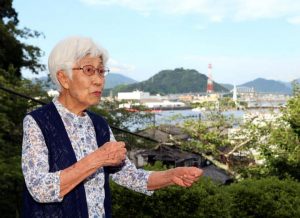Summer following conclusion of Hiroshima summit—Did G7 leaders truly see Hiroshima? Part 3: A-bomb survivors in Motoujina
Jul. 23, 2023
Traces of war remain in area around summit’s main venue
Motoujina area played role in Hiroshima’s time as military center
by Kana Kobayashi, Staff Writer
Since her childhood, the A-bomb survivor Yukiko Suzuki, 93, has lived on an elevated piece of ground in the area of Motoujina-machi (on Ujina Island), in Hiroshima’s Minami Ward, that provides an expansive view of Hiroshima Port (formerly, Ujina Port). The former Imperial Japanese Army’s transportation department (Akatsuki Corps, Shipping Command) was located in the Ujina area, and Ms. Suzuki’s 90-year-old home was once used as residence for the commander of the corps. “The commander would travel to the Akatsuki Corps base from here, on a horse.”
Army established base here
Motoujina-machi is the location of the Grand Prince Hotel Hiroshima, the main venue of the summit meeting of the G7 (Group of Seven industrialized nations), which was held in Hiroshima earlier this year in May. During the Pacific theater of World War II, the Army built anti-aircraft emplacements to shoot down enemy aircraft as well as corps members’ barracks in the area. In that way, Motoujina-machi played a role in Hiroshima’s time as a military city and also incurred damage from the atomic bombing.
On August 6, 78 years ago, Ms. Suzuki was a fourth-year student at First Hiroshima Prefectural Girls’ High School (Prefectural Girls’ School, present-day Minami High School). At the time of the atomic bombing, she had been mobilized to work at Toyo Kogyo (now Mazda Motor Corporation, in Fuchu, Hiroshima Prefecture). Around 6 p.m. that day, she managed to arrive back to her home by boarding a sculling boat and walking along roads. Pieces of glass shattered by the blast were spread all around her house. Glass shards remain to this day in the home’s front door.
As she traveled between her local area and other places after the bombing, she witnessed people with horrific burns and the bones of victims. “Nuclear weapons should never ever be used again. The horrors we endured should never be repeated,” she said resolutely.
According to the Record of the Hiroshima A-bomb War Disaster, published by the Hiroshima City government in 1971, Motoujina-machi is located about 5.7 kilometers from the hypocenter at its farthest location. Many of the homes avoided partial or complete destruction, and many of the residents did not suffer wounds. Meanwhile, the Ujina Shipbuilding Yard, based in Motoujina, lost many of its employees who had been engaged in the demolition of buildings near the hypocenter for the creation of fire lanes. The publication describes 300 evacuated victims that were tentatively housed in the company’s dormitory.
Looking directly at victims was hard
“It was hard to look at the victims directly. Their backs and everywhere were burned, and most of them were bedridden,” said Yoshio Harada, 93, who experienced the atomic bombing in Motoujina-machi. Mr. Harada remembers the tragic situation he witnessed at the shipbuilding yard after the atomic bombing. People assumed to have been brought from the city’s central area with serious burns were laid down in a garage. With adequate medical care unavailable, a kind of zinc oil was applied to their body for the treatment of burns.
Mr. Harada, 15 years old at the time, was a fourth-year student at Hiroshima Municipal First Technical School (present-day Hiroshima Prefectural Technical High School). He was at home on the morning of August 6. He sensed “an extreme flash of light and a boom that shook the ground” while at the entrance area of his home, and in that instant the ceiling was lifted by the bomb’s blast, and glass on the second floor of the house facing west was shattered into pieces. His classmates who were working to dismantle buildings in downtown Hiroshima died in the bombing.
During the period the summit was being held, Motoujina-machi was placed under tight security. The only municipal road connecting to the shore was closed to traffic. Although the area’s residents had to put up with inconveniences, the leaders who stayed in the area did not appear to have been exposed to memories of the war and the atomic bombing right under their feet. Two months have passed since the area was turned into a stage for the important diplomatic event. Mr. Harada’s request of global leaders including those of nuclear weapons states is, “War is wrong. We want peace where everyone can hold hands with each other and get along.”
(Originally published on July 23, 2023)








